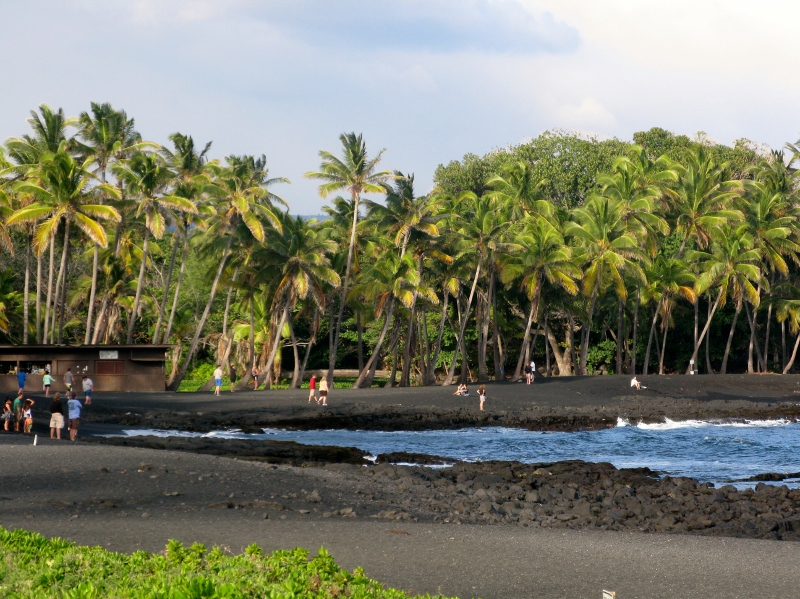Down on Punalu’u beach, the sand is black. Very black. Hence the name – black sand beach. It sits between Pāhala and Nāʻālehu on the island of Hawaii. The sand is created by lava flowing into the ocean: when hot meets cold, the lava explodes and cools and ends up on the beach.
Home to the endangered Green Turtle, Punalu’u’s only detraction is the busloads of tourists that stop off on their way to see the volcano. The name Punalu’u comes from lu’u (diving) and puna (spring). Back in the day, tradition had it that people would dive to the bottom of the bay with empty containers to fill them from the fresh spring water coming from the bay floor.
There’s something magical about turtles. There’s a local legend that features a sea turtle names Kauila. Kauila was born on the beach at Punalu’ku. Her mother, Honupo’okea came out of the water to give birth. She buried her egg in the sand where the sun would keep it warm until it was ready to hatch. When the egg cracked open, a lovely dark baby appeared, looking for all the world like a piece of Kauila wood…no guessing where the name came from then! Kauila stayed at Punalu’u and spent a lot of time at the bottom of a freshwater pond her dad had dug for her. When she breathed, air bubbles would come to the surface and keep the local kids of Ka’u amused. Sometimes, Kauila would change herself into a little girl so that she could play with the local kids and watch over them. Not only did the local people have fresh drinking water, they also had a regular babysitter!
The Hawaiian Honu can live until its 80s and, fully grown, has a shell 4-5 feet in diameter. It can weigh around 350-400 pounds. They’re slow growers, though, and some don’t have kids of their own until they’re 50. It’s pretty much impossible to say if they’re male or female until they reach sexual maturity. Lots of time there to think about things! The males grow very long tails, while the female tail stays short and stubby. They can hold their breath from 2 to 4 hours, and if their heads are cut off, they cry. Actual tears
Once an endangered species, they seem to be making a comeback and with that, there’s a move to allow turtle harvesting for sacred sacrificial ceremonies. Just wait for the furore that will greet that! Yet before the western culture arrived, green turtles were a source of food, tools, and ornamentation for early Hawaiians.
Having lived in Alaska and seen the sense with which the State culls the various herds, and the respect shown to the rights of Alaska Natives, I can only hope that should turtle harvesting be allowed once again that it’s controlled, traditional, and doesn’t result in wholesale massacre.
Share this:
- Click to share on X (Opens in new window) X
- Click to share on Facebook (Opens in new window) Facebook
- Click to share on Pinterest (Opens in new window) Pinterest
- Click to share on LinkedIn (Opens in new window) LinkedIn
- Click to share on Reddit (Opens in new window) Reddit
- Click to share on WhatsApp (Opens in new window) WhatsApp
- Click to share on Pocket (Opens in new window) Pocket
- Click to share on Telegram (Opens in new window) Telegram
- Click to email a link to a friend (Opens in new window) Email













7 responses
Sacred sacrifices! Culture, no doubt. Was there not a great tradition of eating visitors in these parts not so very long ago??
Don’t think they were ever cannibals – Capt Cook was the exception to the rule….
Black beaches are SO exotic. Thanks for sharing this. Venezuela has a few colored beaches. Ocumare de la Costa has an area of shifting black sands with an interesting effect: the grains are iron, so they are magnetic. It is great fun to play with a magnet. Also gives an interesting twist to the idea of energy/ocean/beach.
mmmm… trying to think if I had anything magnetic in my bag…
I rather think it was quite a feature of Polynesian life! Eating your defeated enemies gave you their virtuous properties.